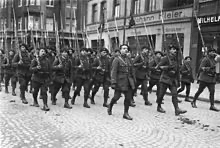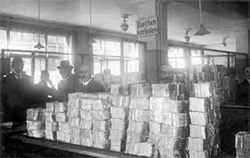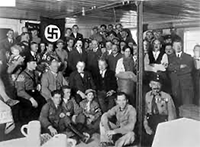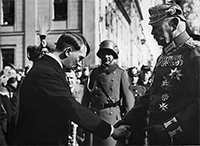The Weimar Republic: Germany's Interwar Government
Part 3: Government Takeover In theory, the Weimar system gave more representation to more people than had previously been the case in the united Germany or any of its predecessors. However, the country did not have only workers and the political spectrum did not have only liberals. Many business owners were opposed to one or more of the new protections granted to workers by the Weimar Constitution; some of those who were opposed took to subverting the system to varying degrees. As well, the idea that the members of the legislative body were more representative of the voting public at large was a sound one as far as representative government theory went; however, in practice, such representation based on proportion of votes cast created a large number of smaller constituencies, which independently had little power to effect change because they lacked the voting power to do so. This had been the case under the empire, when coalition governments had been the norm, but the proportion blueprint exacerbated the proliferation of splinter groups, which had narrow areas of focus, ensuring that the appetite for compromise was diminished. Even more worrying economically was the extremely large amount of money that the German government had to pay to its Great War enemies as reparations agreed to at the signing of the Treaty of Versailles. That amount by 1921 was the equivalent total of US$4.5 billion. The wartime economy had been focused on promoting the war, to the detriment of other industries. A massive rebuilding was needed to repair Germany's infrastructure. And, as part of another article of the war-ending treaty, Germany had given up all of its overseas colonies, handed the resource-rich Alsace-Lorraine back to France, and allowed Allied troops to occupy the Rhineland. All of that amounted to a large deficit in production that, coupled with a huge monetary debt in the form of reparations, had the potential to cripple whatever governmental structure that Germany had. Despite all of this, Germany in the first few years of the Weimar Republic began a comeback of sorts. Exposure to ideas from other countries led to a globalization of the arts scene, which, in turn, drove spending by rich elites who could afford it. Those people were immune to the hyperinflation that was dogging the wider economic recovery. Prices rose, precipitously in many cases. To pay its debts, the government printed more money; that exacerbated the effects of the large price increases. The bottom fell out of the value of the country's money. 
By 1923, the government admitted that it could no longer pay reparations. In response, Belgian and French troops occupied the Ruhr, a source of rich mining and manufacturing companies. Workers went on strike, and production plummeted. At one point, a citizens army swelled to 50,000 people and briefly took control of the Ruhr. The army took back control. In a similar vein were two coup attempts, the Kapp Putsch of 1920 and the Beer Hall Putsch of 1923. Both failed but illustrated the precarious hold that the government had on power. 
An election for president was set to happen in June 1920. War hero Paul von Hindenburg (right) put his name forward as a candidate and was a public favorite to win but didn't get to see himself elected because a military coup took control of Berlin and declared Wolfgang Kapp, a prominent government official, president. In the resulting civil unrest, a general strike led to violence in the streets and an uprising by Communist forces. The coup government collapsed, and troops arrested Kapp. He died in prison, awaiting trial for reason. A resurgent Reichstag extended Ebert's term of office for another five years. Then, in Munich in 1923 was the Beer Hall Putsch, an attempt by Adolf Hitler and members of the Nazi Party to take over the government. The coup attempt failed, and Hitler and war hero Erich Ludendorff were among those arrested; the former was convicted and sent to prison, and the latter was acquitted after claiming that he was an accidental participant. Ebert died in February 1925, and the government scheduled a new presidential election. No candidate got the necessary majority of the votes, so the government proclaimed a runoff. Hindenburg, despite garnering the fewest votes of any of the candidates, was the choice for the right-leaning political parties for the runoff. Hindenburg barely won the second election and was proclaimed President of the Republic. At 78, he took office, on May 12, 1925. 
Despite all of that uncertainty, Germany had, a year before, convinced a group of American bankers to adopt the Dawes Plan, an attempt to help Germany pay down its reparations total: American banks lent the German government money, in exchange for taking over the mortgage on the German National Bank, the German national railways, and many other German industries. As well, German representatives had signed the Locarno Treaties, in October 1925, cementing the German borders with Belgium and France, ending the Allied occupation of the Rhineland, and paving the way for Germany to be admitted into the League of Nations, which happened in 1926, in conjunction with Germany's also agreeing to arbitration conventions with Belgium, Czechoslovakia, France, and Poland. In less than a decade, the demand for Germany to bear the War Guilt had lessened, replaced in some respects by a need for international cooperation. As a capstone, Gustav Stresemann, who had served as Chancellor for three months but was much more well-known as foreign minister, received the Nobel Peace Prize in 1926. The Great Depression hit in 1929, crippling the economies of Europe, the United States, and most other countries in the world. American banks had agreed in August of that year to the Young Plan, another program to settle reparation debt, but the economic devastation was too great in America for such niceties to continue and so, in waves, American banks withdraw their lines of credit to German companies. Unemployment within Germany skyrocketed, and public confidence in the government's ability to right the ship waned. Into this void stepped the National Socialist German Workers' Party (NSDAP), which became much more well-known as the Nazi Party. Hitler had served his time in prison and was once again leading the party. In the elections of 1930, the NSDAP got 19 percent of the vote; such a total was not large by majority standards, but that total was the second-largest percentage of any political party, trailing only the vaunted SDP. 
Political disarray was rife in the early 1930s. Chancellors didn't last long, and public impatience grew. Hindenburg dissolved the Reichstag in 1932 and called for new elections. He won re-election, in July. The Nazi Party won the most seats but not a majority, and so the answer was again a new election, in November of that same year. Again the Nazi Party won the most seats, but again it was not enough for a majority. A coalition government continued. In January 1933, Hindenburg named Hitler Chancellor. Right away, Hitler took aim at a greater role. He convinced Hindenburg to dissolve the Reichstag and then, after the Reichstag fire, signed the Fire Decree, suspending civil liberties throughout the country. In new elections, the Nazi Party won a majority. Soon, the new government had passed the Enabling Act, removing lawmaking powers from the Reichstag and giving them to the top-level government. As well, all political parties but the Nazi Party were banned; prohibited as well were labor unions. The national government took over running of the states. 
Hindenburg was still President and, technically, head of state. However, Hitler, as Chancellor, had enormous power and a parliamentary majority. Hindenburg battled cancer and then lost, dying in August 1934. Just before, Hitler and his Cabinet had passed a law abolishing the office of President and merging its powers with that of the Chancellor. When Hindenburg died, the republic died as well. First page > Empire to Shared Government > Page 1, 2, 3 |
|
Social Studies for Kids
copyright 2002–2025
David White




